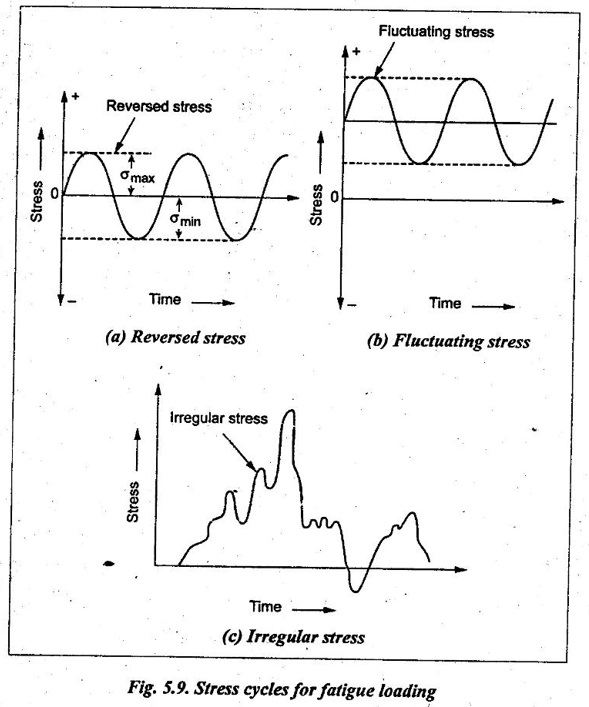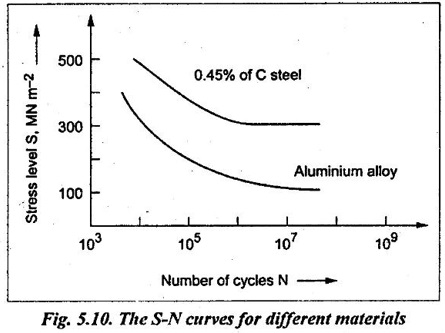Fatigue fracture defined: The fatigue fracture is defined as the fracture which takes place under repeatedly applied fatigue stresses.
FATIGUE FRACTURE
1. What is Meant by Fatigue Fracture?
✔ Fatigue fracture defined: The fatigue fracture is defined as the fracture which takes place under repeatedly applied fatigue stresses.
✔ In other words, the behaviour of the materials subjected to fluctuating or repeated loads is called fatigue.
✔ Three main features that distinguishes the fatigue fracture are:
(i) Loss of strength;
(ii) Loss of ductility; and
(iii) Increased uncertainty in strength and service life.
✔ The fatigue fracture occurs at stresses well below the tensile stress of the materials.
✔ Fatigue must be considered in machine components subjected to continuously cyclic loading such as motor shafts, bolts, springs, gear teeth, valves, turbine blades, airplanes, automobile and gas-engine parts, suspension bridges, wire ropes and many others.
✔ Since 80 to 90% of the total failures of high-speed machine parts is due to fatigue, therefore the study of fatigue failure is very important.
2. Stress Cycles
Fig.5.9 illustrates the different arrangements of fatigue loadings.
✓ Fig.5.9 (a) shows the arrangement of the reversed stress.
✓ Fig.5.9 (b) shows the arrangement of the fluctuating stress.
✓ Fig.5.9 (c) shows the arrangement of the irregular stress.

3. Mechanism of Fatigue Fracture
✔ Fatigue fracture begins at irregularities on the surface imperfections such as machine marking and slip steps. The nucleation of microcrack is due to the slip movements. The slip movements starts within few cycles of loading. The microcracks act as the points of stress concentration.
✔ As the cycles of loading continue, the microcrack propagates and grows in its size. In brittle materials, the crack grows to a critical size very fastly. But in ductile materials, the crack keeps growing until the remaining area cannot support the load. So the fatigue fracture in ductile materials occur suddenly.
✔ The high temperature increases the mobility of atoms, facilitating slip and hence the fatigue fracture.
4. S-N Diagram
✔ The S-N diagram can be obtained by plotting the number of cycles of stress reversals (N) required to cause fracture against the applied stress level (S), as shown in Fig.5.10.

✔ It can be seen from the Fig.5.10 that the fatigue strength is more for steels than for non-ferrous metals (such as aluminium) and their alloys.
✔ Fatigue stress (or fatigue strength): The stress at which a metal fails by fatigue is termed as fatigue strength.
✔ Fatigue limit (or endurance limit): It is defined as the value of stress below which the material will not fail even when it is loaded for infinite number of cycles.
✔ Fatigue life: It is the total number of cycles required to bring about final fracture under a given condition of use.
5. Factors Affecting Fatigue Strength
1. Fatigue strength is influenced by many factors such as chemical composition, grain size, and amount of cold working.
2. Fatigue strength is high at low temperatures and gradually decreases with rise in temperature.
3. Environmental effects such as corrosion of the product by moisture decreases the fatigue strength.
4. The design of the product also influences the fatigue strength. Because changes in shape/size may change the stress gradients and residual stresses of the materials.
6. Prevention of Fatigue Failure
The following methods can be adopted to prevent the fatigue failure.
1. Use of good design to avoid stress concentration by eliminating sharp recesses and severe stress raisers.
2. Control of the surface finish by avoiding damage to surface machining, punching, stamping, shearing, etc.
3. Reduction of corrosion environmental effects by surface heat treatments like polishings, coatings, carburizing, nitriding, etc.
4. The material should have fine grain structure and also it should be free from residual stresses and dislocations.
No comments:
Post a Comment